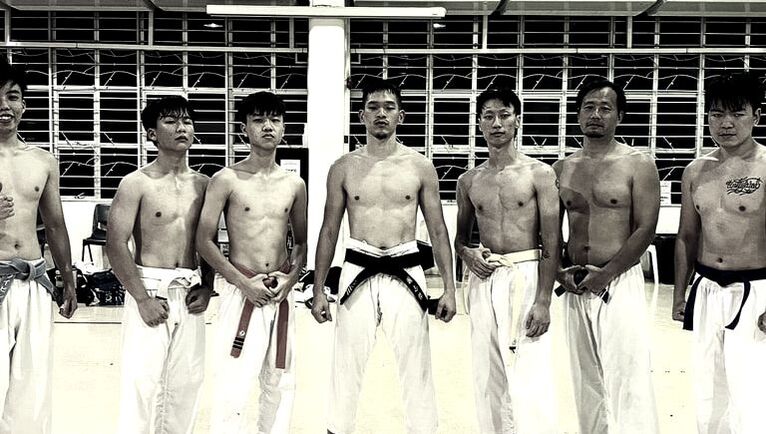FIGHTSPUR KARATE
History
Our founder Chia Zhi Jie, was inspired by the vision of elevating karate's reputation to rival the stereotypical "tough and effective" image that Muay Thai, Boxing, MMA and Kickboxing has. His goal was to capitalise sport karate's evasiveness and footwork by importing aspects of boxing and kickboxing to make the style practical. Despite having a background in Go-Ju Ryu, he drew very little from that school, instead drawing from his experience as a competitor in sport kumite and amateur kickboxing.
In the early days, he taught classes independently, not under any organisation's or style's banner. When asked about the "style" he was teaching, he simply replied: "we are not practicing any style, we just do karate that works". Eventually, he gave the club a name - FightSpur Karate.
Our founder Chia Zhi Jie, was inspired by the vision of elevating karate's reputation to rival the stereotypical "tough and effective" image that Muay Thai, Boxing, MMA and Kickboxing has. His goal was to capitalise sport karate's evasiveness and footwork by importing aspects of boxing and kickboxing to make the style practical. Despite having a background in Go-Ju Ryu, he drew very little from that school, instead drawing from his experience as a competitor in sport kumite and amateur kickboxing.
In the early days, he taught classes independently, not under any organisation's or style's banner. When asked about the "style" he was teaching, he simply replied: "we are not practicing any style, we just do karate that works". Eventually, he gave the club a name - FightSpur Karate.
The Style
In popular culture, a general term used to describe karate styles that do not fall into one of the many traditional branches is: freestyle karate. So technically, the style of karate practiced in our school falls under this umbrella term. But over time, as we grew, both people outside our school who encountered us in events and competitions, and our own students, started to refer to our training methodology and fighting style by the name of our club - FightSpur Karate. And so we adopted it and made it our own. We consider ourselves a blend of kickboxing, full contact karate and sport karate.
Ever seen karate fighters in MMA and kickboxing successfully using that evasive fighting style and timing? That's what we are trying to achieve here at FightSpur! Classes at FightSpur combines principles of both point-fighting sport karate and kickboxing. It incorporates sport karate's iconic long range attacks, distance control and footwork, with kickboxing's long combinations and inside fighting. This is a holistic system optimised for self-defence and competitive fighting. We aim to make karate an effective and respectable striking base, to be on par with boxing, muay thai and kickboxing.
The style is based on realism and practicality. Replacing the traditional training methods of kata, kihon and kumite, with a more modern approach, using shadowboxing, pad work, partner drills, agility training and sparring as its primary training methods.
In popular culture, a general term used to describe karate styles that do not fall into one of the many traditional branches is: freestyle karate. So technically, the style of karate practiced in our school falls under this umbrella term. But over time, as we grew, both people outside our school who encountered us in events and competitions, and our own students, started to refer to our training methodology and fighting style by the name of our club - FightSpur Karate. And so we adopted it and made it our own. We consider ourselves a blend of kickboxing, full contact karate and sport karate.
Ever seen karate fighters in MMA and kickboxing successfully using that evasive fighting style and timing? That's what we are trying to achieve here at FightSpur! Classes at FightSpur combines principles of both point-fighting sport karate and kickboxing. It incorporates sport karate's iconic long range attacks, distance control and footwork, with kickboxing's long combinations and inside fighting. This is a holistic system optimised for self-defence and competitive fighting. We aim to make karate an effective and respectable striking base, to be on par with boxing, muay thai and kickboxing.
The style is based on realism and practicality. Replacing the traditional training methods of kata, kihon and kumite, with a more modern approach, using shadowboxing, pad work, partner drills, agility training and sparring as its primary training methods.
FightSpur's Belts
The belt promotion system in FightSpur is unique in karate.
Typically, in most karate schools, promotions are earned by students sitting for a test (grading). The contents of this test usually involves the performance of pre-memorised forms (kata), some sparring and maybe some physical conditioning. The problem here is that these tests do not adequately filter out people who cant fight. As testers are inclined to allow unqualified students through, as they have paid hefty testing fees. Over times this causes a dilution as a slow decline in the quality of belts.
Promotions in FightSpur are based solely on performance and fighting competency, and given when the instructors observe that a student is ready for the next rank. We believe that the rank a practitioner wears on his/her waist, should mean something. It should be a clear indication of that person's fighting ability.
The belts in FightSpur are held to an extremely high level, with a black belt taking an average of 10-12 years of training multiple times a week.
The belt promotion system in FightSpur is unique in karate.
Typically, in most karate schools, promotions are earned by students sitting for a test (grading). The contents of this test usually involves the performance of pre-memorised forms (kata), some sparring and maybe some physical conditioning. The problem here is that these tests do not adequately filter out people who cant fight. As testers are inclined to allow unqualified students through, as they have paid hefty testing fees. Over times this causes a dilution as a slow decline in the quality of belts.
Promotions in FightSpur are based solely on performance and fighting competency, and given when the instructors observe that a student is ready for the next rank. We believe that the rank a practitioner wears on his/her waist, should mean something. It should be a clear indication of that person's fighting ability.
The belts in FightSpur are held to an extremely high level, with a black belt taking an average of 10-12 years of training multiple times a week.

